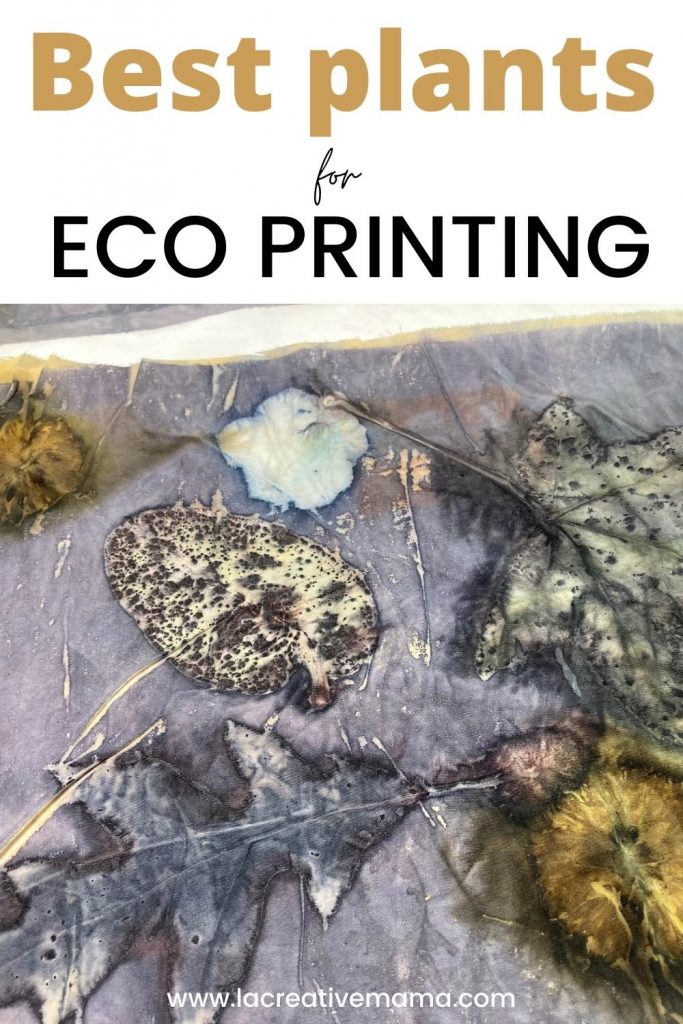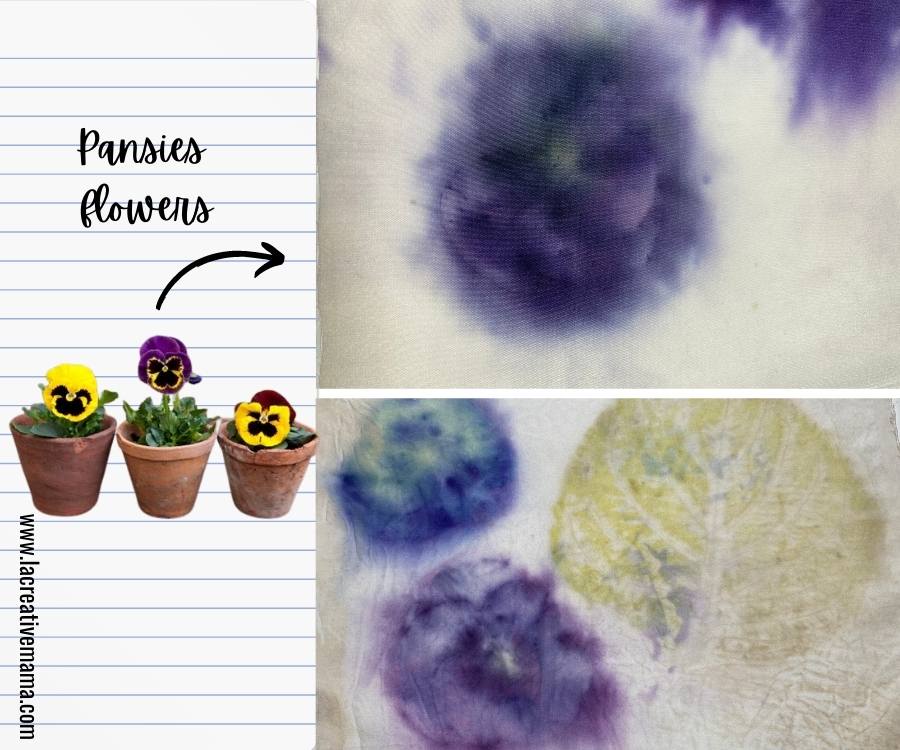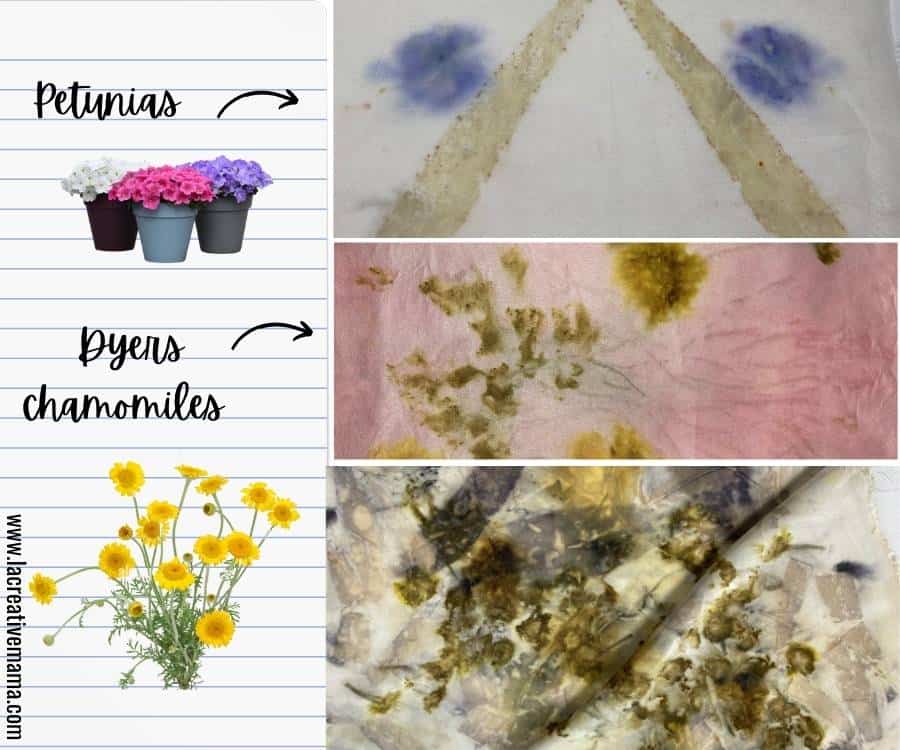Hi Creative Mamas! A lot of my students come to me to learn how to eco print but I feel that the most important step in the eco printing process is to know which are the best plants to use.
You can create beautiful eco prints that are bright, long lasting and defined. You can also use plant printing to create splashes of color and subtle effects. Eco printing is a form of natural dyeing and a very experimental one.
You can combine eco dyeing (using natural dyes) with botanical printing. You can use blankets, different mordants and techniques to create all sorts of innovative and amazing botanical printing on paper and fabric.

But in order to get best results in a consistent fashion you really need to know which plant material to use.
These are plant dyes which inherently have the ability to provide bright and long lasting natural color and therefore beautiful prints.
In this post I will list my favorite eco printing leaves and flowers. This list will save you lots of frustration and will avoid you choosing plants that won’t deliver beautiful results.
Best plants for eco printing
Depending on the area where you are and the season, you will be able to access different types of flowers and leaves to incorporate in your printing.
These plants have great dyeing qualities and will yield good results by themselves without the help of an iron solution, iron dip, assists or blankets.
One important thing to note is that eco printing does require to work with mordanted fabrics. There are a lot of mordants to choose from (some are toxic chemicals).
I only use Alum since its a non toxic alternative and its safe for us and for the environment. Soy milk is a very popular alternative as well.
Download your plant list
Download the FREE Eco printing plant list by completing the form below!
Best leaves for eco printing
All of these leaves can be used for eco printing on linen and cotton (cellulose fibers) as well as for eco printing on silk and wool (protein fibers).
Birch
Birch leaves produce beautiful leaf prints. They are smaller leaves and a great complement to use when eco printing with a variety of leaves and flowers.
I have two birch trees in my neighborhood and it’s a constant source of inspiration for my printing!
Black alder
I like using black alder for eco printing on wool because its a textured leaf.
This ensures that the print is transferred even when using thicker materials such as woolen fabrics.
Eucalyptus
Eco printing with Eucalyptus leaves is my favorite. Eucalyptus has high tannin content which makes it a great plant for botanical printing.
In the image below you can see its natural brown reddish printing color as well as the black color produced by enhancing the leaves with ferrous sulfate.
As far as I know there are over 700 hundred different varieties of Eucalyptus trees. You can easily identify this tree by the unique identifiable smell that you get from the eucalyptus leaves.
So if in doubt, break a leaf and smell it.

Maple
Eco printing on linen using maple leaves is very satisfying. The shape of these leaves will create beautiful and well defined prints all year round!
I have one maple tree 5 minutes away and it gives me different prints depending on the time of year in which I am collecting the leaves 🙂
Gum tree
Eco prints from gum trees are also very nice.
Gum trees are closely related to eucalyptus and depending where you are in the world you will find different varieties available to you.
Silver Dollar
Silver dollar is a variety of eucalyptus and to be honest it’s my favorite leaf for eco printing.
The photo below shows the golden brown print produced on cotton fabric. This fabric was mordanted and treated with an iron blanket. You can learn how to make these techniques in the Eco Printing on fabric course.

Pomegranate & St John’s Wort
Both pomegranate and St john’s wort are great options for printing. They are nice to grow in your own dye garden and produce beautiful flowers as well.
Woad
Woad leaves are great and can be used as a substitute to indigo leaves in natural dyeing. They have good dyeing properties and are fun to experiment with!
Avocado
I have an avocado tree at home. I use these leaves as natural dyes as well as for botanical printing.
The photo below shows an print on paper using avocado leaves and iron dips.

Fennel & Crepe Myrtle
I haven’t used these leaves much because they are not available in my area. However, I have colleagues who have achieved lovely prints from the outline of these leaves so I recommend to experiment with them if you have them nearby.
Sweetgum or Liquidambar
Liquidambar is very prolific in many areas and if you look for them you will probably find them!
The leaf outline is similar to the maple leaf and its so high in tannin content that it creates very versatile results depending on the type of technique you use.

Hydrangea
Hydrangea leaves are my go to all year round. I grow them in my garden and they are textured and thick leaves.
They produce a nice green natural print and enhanced with iron solution will provide you with a rich brown color.
Peony & Rose
Peony and rose leaves are great to use for printing when you have a bouquet or a flower arrangement. I don’t like to waste anything and I have printed silk scarves using left over rose leaves many times 🙂
Oak
I just love the outline of oak leaves. Oak tree produces acorns which are a fantastic natural dye and a great way to create natural black color.
I use them all year round and they seem to work nicely with all sorts of different techniques!

Sage, Elderberry & Coreopsis
These three leaves are all great! My favorite is the coreopsis which grow in my dye garden area. They grow abundantly and I always have fresh coreopsis leaves all year round.
Best flowers for eco printing
There are many flowers that I regularly use for natural dyeing but this list is specific to eco printing on fabric and paper.
Rose
Rose petals are super easy to use in any eco printing project. You can use them fresh or dried. Never throw away an old bunch of roses, keep them for your future prints!
Goldenrod
I have just planted 4 goldenrods in my dye garden. They grow abundantly in most types of soils and will deliver great botanical prints in both paper and fabric.
Coreopsis
I grow coreopsis at home and I have yellow flowers all year round. This plant seems to grow and grow and you need to keep it trimmed but you can get amazing vibrant yellow prints from it.
Coreopsis are great to use in combination with iron blankets and an iron dip.

Marigold
Marigolds are great to print and dye with. The bad thing about them is that you need to re plant them every spring, they don’t seem to last through the winter (at least here in New Zealand).
I use marigolds a lot in my natural dyeing practice both in immersion dyeing and in solar power dyeing.
Chrysanthemum
These little flowers are great to add interest and use in combination with other flowers. I like the yellow petal variety but they come in all sorts of colors.
Pansies
Pansies are great to get big splashes of color. I have the purple ones growing in my dye garden but I am now experimenting with other kinds of petal colors.
They react nicely to eco print assists such as iron solution.

Geranium & St John’s wort
Geraniums are great for hapazome method (flower bashing) which is super fun to do with the kids!
Hibiscus
Hibiscus or China Rose grows really well all year round. They are hardy plants and they come in different colors such as red, pink, yellow and orange.
The photo below shows the purple print that you can get from the red flower variety.

Petunia & Dyer’s chamomile
Petunias come in different colors as well. The photo below shows a simple straight forward print from the purple flower variety. If enhanced with different techniques this humble flowers will deliver amazing and surprising color.
Dyer’s chamomiles are great flowers to use in both natural dyeing for good solid color and in botanical printing.

The middle photo shows the dyer’s chamomiles enhanced with ferrous sulfate over a cochineal dyed silk fabric.
The photo below that shows the same flowers on a white silk fabric.
Download the plant list here!
Eco printing techniques
There are different ways for getting great results in eco printing. Check out these tutorials about making beautiful fabrics and papers by using botanical printing and eco dyeing.
This is a great beginners guide on eco printing on fabric and will allow you to create your own DIY fashion items such as this great eco printed drawstring bag, a tote bag and a cross shoulder bag.

You can also have lots of fun by eco printing on paper. Check out how to mix eco printing and tea dyeing on paper as well as enhancing the prints by using food coloring as well.
Bundle dyeing is also a way to print on silk fabric and to create botanical prints. Check out this eco printed silk scarf using iron water and sunflowers.
Using fresh and dried plants
You can use fresh leaves and flowers as well as died ones. I like to use fresh plant materials when possible but I have always achieved great results using both dried and fresh plants.
Eco printing process safety measures
Always check to make sure that whatever plant you use it’s not toxic and it won’t create any allergies once you’re steaming them.
You can do a quick google search by typing the name of the plant + toxicity e.g.: “coreopsis toxicity inhalation” or “eucalyptus toxicity inhalation”


Have you ever used morning glory for eco printing on linen/cotton?
Hi Ellen,
I haven’t had much experience with Morning glory myself but some of my fellow eco printers seem to be getting nice results from them so it’s definitely worth a try! Make sure you prepare the fabric accordingly so that its receptive to the dye!
Is there a flower that will pound print in red. I have lots of purples, blue and yellow but no red.
Hi Anne, thanks for reaching out! I find that marigolds which are dipped in iron give me a brick red color. check out this post https://lacreativemama.com/eco-printing-on-paper/ its on paper but you get the idea 🙂 Hope this helps!
Have you had success with the lavender plant with eco printing? I’m curious if I could get a print from the leaves or the flowers themselves. Thanks in advance!
Hi Jess,
You will be able to get a print of both flower and leaf but you will probably need to assist with an iron dip because lavender doesn’t have good dyeing qualities… I always recommend to stick to the suggested plants so that you get good prints from the get go but experimenting and branching out is also part of the fun!!!
Have you ever used water Lilly pads ? Do you know of anyone who had used them ? What kind of results did you get ?
Hey Margo, no I haven’t sorry 🙂
How to use alum